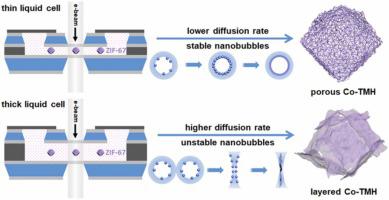Applied Catalysis B: Environment and Energy ( IF 20.2 ) Pub Date : 2022-02-01 , DOI: 10.1016/j.apcatb.2022.121164 Liangping Xiao 1 , Guanghua Wang 1 , Xingchen Huang 1 , Shiyuan Zhou 1 , Rusen Zhou 1 , Youhong Jiang 1 , Sangui Liu 1 , Gen Li 1 , Haimei Zheng 2 , Shi-Gang Sun 1 , Hong-Gang Liao 1

|
Materials derived from MOFs have great potentials in energy conversion. However, the nanoscale transformation processes of MOFs derivatives remain unknown. Herein, by using in-situ liquid phase TEM, we directly visualize the MOFs etching processes. For the first time, unexpected nanobubble stability controlled transformation mechanism of ZIF-67 to porous or layered cobalt transition metal hydroxide (Co-TMH) is identified. Voids in MOFs migrate and merge to form nanobubbles due to structural collapse. Under slow diffusion conditions, nanobubbles move slowly and Co-TMH clusters generate on the nanobubble interface, further favoring the formation of internal nanocages and porous structures. On the other hand, a fast diffusion leads to rapid nanobubbles generation, aggregation and reshaping, inducing layered structure formation. Inspired by in-situ observation, we further synthesize porous Co-TMH at − 80 ℃ under inhibited diffusion conditions, which exhibits excellent catalytic performance on CO2 reduction reaction.
中文翻译:

原位液相TEM揭示的高效CO2还原MOFs衍生物转化机制
源自 MOF 的材料在能量转换方面具有巨大潜力。然而,MOFs衍生物的纳米级转化过程仍然未知。在此,通过使用原位液相 TEM,我们直接可视化 MOF 蚀刻过程。首次确定了出乎意料的纳米气泡稳定性控制 ZIF-67 向多孔或层状钴过渡金属氢氧化物 (Co-TMH) 的转化机制。由于结构坍塌,MOF 中的空隙迁移并合并形成纳米气泡。在慢扩散条件下,纳米气泡移动缓慢,Co-TMH 簇在纳米气泡界面生成,进一步有利于内部纳米笼和多孔结构的形成。另一方面,快速扩散导致纳米气泡快速产生、聚集和重塑,从而诱导层状结构形成。灵感来自现场通过观察,我们进一步在-80 ℃、抑制扩散条件下合成了多孔Co-TMH,其对CO 2还原反应表现出优异的催化性能。











































 京公网安备 11010802027423号
京公网安备 11010802027423号